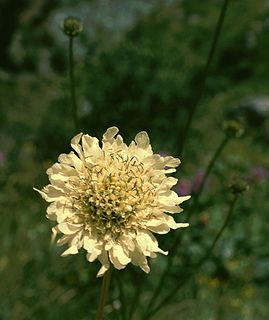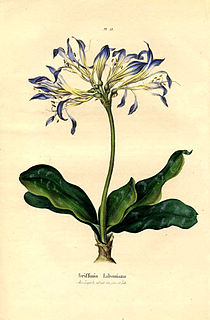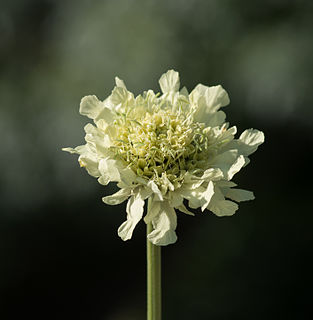
Cephalaria is a genus of about 65 species of flowering plants in the family Caprifoliaceae, native to southern Europe, western and central Asia, and northern and southern Africa.

Scabiosa is a genus in the honeysuckle family (Caprifoliaceae) of flowering plants. Many of the species in this genus have common names that include the word scabious; however some plants commonly known as scabious are currently classified in related genera such as Knautia and Succisa; at least some of these were formerly placed in Scabiosa. Another common name for members of this genus is pincushion flowers.
Flora of Azerbaijan or Vegetation of Azerbaijan refers to the plants, trees, flowers which can be found in Azerbaijan.
Acmella leucantha is a species of flowering plant in the aster family, Asteraceae. It is endemic to Ecuador, where it is known from three locations in the Andes and one on Puná Island. The Andean subpopulations grow in forests and the dry vegetation of mountain valleys. The island subpopulation occurs in coastal habitat. The species is threatened by habitat destruction, including deforestation on Puná Island.
Meriania leucantha is a species of plant in the Melastomataceae family. It is endemic to Jamaica.

Belsazar de la Motte Hacquet was a Carniolan physician of French descent in the Enlightenment Era. He was a war surgeon, a surgeon in the mining town of Idrija, and a professor of anatomy and surgery in Laibach. He researched the geology and botany of Carniola, Istria, and nearby places, and was the first explorer of the Julian Alps. He also did ethnographical work among the South Slavic peoples, particularly among the Slovene-speaking population. He self-identified primarily as a chemist and introduced the methods of chemical analysis to Carniola.

Salvia leucantha, the Mexican bush sage, is a herbaceous perennial that is native to subtropical and tropical conifer forests in central and eastern Mexico. The flowers are usually white, emerging from coloured bracts. It is not frost hardy, but is often grown in warmer latitudes for its prominent arching velvety blue or purple inflorescences.
Millettia leucantha or sathon is a species of plant in the Fabaceae family.

Griffinia is a genus of Brazilian plants in the Amaryllis family, subfamily Amaryllidoideae. It includes 21 known species which are endemic to Brazil in South America. The most closely related genus to it is the monotypic Worsleya.
Sphenarches is a genus of moths in the family Pterophoridae. Species in this genus are distributed in regions with pantropical climates, and are also found in Japan and southern Canada. Host plants for the genus are Dolichos lablab, Lagenaria leucantha clavata, and L. leucantha gourda.
Phyllonorycter cephalariae is a moth of the family Gracillariidae. It is known from southern France, Croatia, Greece, Hungary and Serbia.
C. laevigata may refer to:
Dielsiodoxa is a small genus of flowering plants in the family Ericaceae. The species, all endemic to Western Australia, include:
Sideritis leucantha is a plant species in the genus Sideritis.
S. leucantha may refer to:

Cochylis epilinana is a species of moth of the family Tortricidae. It is found in most of Europe, Asia Minor, Israel and northern Syria.
Phtheochroa purana is a species of moth of the Tortricidae family. It is found in France, Italy, Croatia, Bosnia and Herzegovina, Hungary, Romania and Asia Minor.
Dolichometra is a monotypic genus of flowering plants in the Rubiaceae family. The genus contains only one species, viz. Dolichometra leucantha, which is endemic to the East Usambara Mountains in Tanzania.

Cephalaria alpina, commonly known as the yellow cephalaria, alpine scabious or yellow scabious, is a species of flowering plant in the family Caprifoliaceae native to the Alps in Europe.










